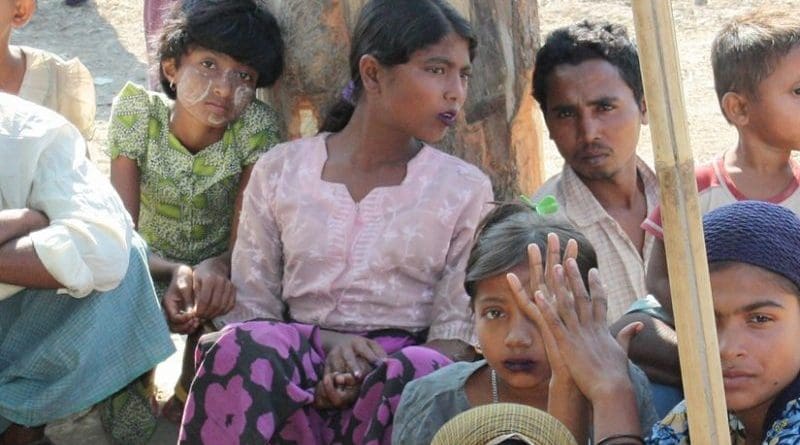Annihilation Of The Marginalised: The New Normal In Myanmar – Analysis
They have been called by different names – Rohingya, Bengali, Kalar – depending on whether one is referring to their ethnicity, the language they speak, or to the colour of their skin. These pejorative descriptions have provided their Buddhist antagonists among Myanmar’s civilian, political as well as military circles to be part of project of annihilation; to cleanse the country off these 1 million unwanted people. Many Rohingyas have fled the country. And a large majority who still remain are simply awaiting a process of slow death under various pretexts. Their eventual extermination, however, will be the only probable end game as the world continues to provide only lip service to the systematic and officially sponsored violation of human rights in new age Myanmar.
Myanmar is a strange country. At one level, its yearning for democracy and reforms has remained one of the often quoted narratives in history, capable of evoking academic debates and unending coffee table talk. The continuing struggle to send the powerful military to the barracks and allow the civilian politicians to steer the country on the path to development has been no less than exemplary. At another level, however, hatred for the country’s minority ethnic groups including the Rohingya has curiously united the military and those who oppose them. The campaign to retain prominence of the majority Bamars vis-à-vis the other ethnicities thereby becomes a highly unequal one, pitting the Buddhist 70 per cent of the population with state support versus the non-Buddhist 30 per cent.
While the Rohingya are certainly not the only group to have faced systematic persecution by the Bamar-dominated power centre, the complicity of the state in annihilation projects initiated by Buddhist religious bodies and local administration in the Western Rakhine state certainly makes their case unique. Out of the 1 million unrecognised Rohingya, about 1,20,000 live in internment camps – being victims of the communal riots since 2012. Thousands have fled Myanmar to countries like Malaysia and Bangladesh and hundreds are dead, victims of both direct and indirect assaults. Those Rohingya, estimated to be about 800,000 in number, who are still away from the camps and have not become refugees in strange, foreign lands, have witnessed their economic, political as well as religious rights disappear. This breakup of victims is unverifiable, as Myanmar has systematically prohibited any direct monitoring of the Rohingya plight by international aid organisations, reminding them of their obligation to be “impartial.” And yet these numbers somewhat portray the misery and tribulation that continue to sweep the Rohingya off their marginalised and wretched existence.
With this understanding, the 9 October 2016 episode becomes only a pretext for continuing the pogrom. On that day, according to official accounts, hundreds of armed Rohingya carried out simultaneous attacks on security posts along the Myanmar-Bangladesh border region, killing nine police personnel and three other army personnel. Several others were injured. The arrests of two attackers and their subsequent interrogation revealed the involvement of an unknown Islamist militant group, the Aqa Mul Mujahideen (AMM), understood be an offshoot of the defunct Rohingya Solidarity Organisation (RSO). The Myanmar military has described the AMM to be led by Haviz Tohar, a Rohingya in exile, trained by the Taliban in Pakistan. In somewhat conflicting descriptions, videos have emerged where a group led by another person – Abu Ammar Junooni – flaunts several armed cadres. The group has stopped short of declaring a jihad on Myanmar and has merely asked for the rights of the Rohingya to be recognised.
Notwithstanding the exaggerated official claim that AMM has 400 armed cadres operating in the Maungdaw region, a statement that even the state counsellor Aung San Suu Kyi has distanced herself from, what has followed in Rakhine state is an annihilation campaign. Operations by the military has resulted in the killing of 33 attackers involved in the 9 October episode, according to official accounts. Rohingya sources, however, document at least 133 deaths, a large number of sexual violence cases in which women and children have been targeted by soldiers, and countless instances of torture. Attacks by helicopter gunships and ground operations have wiped out villages and livestock, burning down at least 1,250 homes and other structures, forcing almost 30,000 Rohingya to seek refuge in neighbouring Bangladesh, where they are largely unwelcome, unsupported, and are likely to be pushed back.
Whether the wretched luck of the Rohingya will ever change is no longer a relevant question. As the friendless, stateless, and right-less Rohingya look down a long and dark alley to an obvious process of gradual obliteration, the Myanmar military has announced its plans to train and arm Buddhist civilians to protect their villages. The erstwhile human rights defendant and now a confirmed politician, Aung San Suu Kyi has pointed at the “unfair” treatment of Myanmar by human rights groups. Feeble protests do take place. A Singaporean has submitted a memorandum to the Myanmarese embassy. Malaysia has cancelled two football matches with Myanmar. Little else has changed as a committee appointed by Suu Kyi headed by former United Nations Secretary General Kofi Annan tours Myanmar to take stock of the situation. The Committee does not have even a single Rohingya as its member. The new normal in Myanmar is not worth anybody’s time.
This article was published at IPCS

